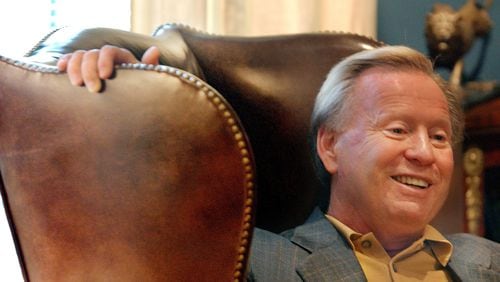In 1970 while putting together the blueprint for what became Post Properties, and when he couldn’t yet afford office space, John Williams held regular meetings at the Sandy Springs International House of Pancakes. Mostly he drank coffee until IHOP staffers required he buy breakfast with every new — and usually protracted — meeting. So he ordered pigs in a blanket, which he ate everyday, sometimes twice a day.
From these dubious culinary meetings, Williams revolutionized the apartment business. Where traditional new apartment complexes of the 1970s were comprised of industrial blocks of brick buildings with parking lots, he created a sense of place. Williams planted tulips, his mother’s favorite flower.
He supplied his buildings with quality appliances, and his complexes were stocked with multiple gas grills, hot tubs, swimming pools and impeccable landscaping. The tulip became the company logo, and over time there’s no telling how many thousands he imported from Holland. But when he resigned as chairman of Post Properties in 2003 the company had approximately 30,000 apartments.
“Back then nobody planted a stick or shrub,” said Johnny Isakson, then a young realtor who sat in on the IHOP meetings. “I go around the country today and I see all these gardens in apartment complexes, office parks, the center islands on highways, and that’s John Williams’ influence.”
John A. Williams, 75, died unexpectedly, April 16. No cause of death was given.
A memorial service is scheduled Monday, April 23 at the Peachtree Presbyterian Church, 3434 Roswell, Road, Atlanta. A reception follows at the Cherokee Town Club, 155 West Paces Ferry Rd NW, Atlanta.
Though apparently he seldom went into detail, at least publicly, Williams often told interviewers “I came from the wrong side of the tracks,” or “we grew up poor as church mice.”
He attended Southwest Atlanta High (now Mays High) and then Georgia Tech. His longtime friend, the former Georgia Governor Roy Barnes, said recently that Williams was a co-op student, alternating work for one quarter and school the next. After graduating he went to work for Georgia Power’s real estate division, eventually meeting Isakson, then with Northside Realty Associates, and Barnes, then a litigator fresh out of law school.
The trio remained personally tight for over a half century. But in the mid 1980s they were politically crucial in creating a constitutional amendment allowing for the state’s first community improvement district. In a trip to Dallas, Williams had studied that city’s “Business Improvement Districts,” and convinced the Democrat Barnes and the Republican Isakson to sway the Senate and House respectively to approve a CID referendum. They did, and it ultimately passed voters’ muster in November 1985.
CID’s, where a mini-district of businesses form almost like a small town, agree to pay more taxes then use the money to improve and build the district, now dot Georgia from Florida to Tennessee.
“Only someone with the vision of [Williams] could pull that off,” said Tad Leithead, another longtime friend and now chairman and interim executive director of the Cumberland CID. “First you get a constitutional amendment. Then you have to ask commercial business owners to tax themselves. Then you have to convince them you will use that money for infrastructure improvements.”
The Cobb (now Cumberland) CID has now spearheaded 27 years of upgrades including the Cumberland loop, or Kennedy Interchange, allowing access to all quadrants of the I-75/285 interchange. There are currently 27 CID in the state system.
Isakson, now a U.S. Senator, called that original CID “The single best legislative project for me.”
It was also an early example of Williams’ rigorous bipartisanship.
“He always said,” Barnes pointed out, “that what was wrong with the country was that each party thought they had a monopoly on the best ideas.”
Although nationally known for his real estate virtuosity, he may have garnered higher praise locally for his community commitment.
Early on, his focus was on his home base in Cobb County — he was chairman of the Cobb Chamber of Commerce in 1982 and 1992. But eventually his breadth encompassed the entire 20-county region. Among his sprawling opus of achievements, he led the Metro Atlanta Chamber in 1999, and helped then-Gov. George Busbee start a metropolitan business organization to help consolidate the region’s economy.
“There were two things where he was particularly influential with me,” Barnes said. “One, we are so interconnected there has to be regional cooperation and two, there has to be mass regional transportation.”
In the early 2000s Williams donated $10 million to something he’d long envisioned, the $150 million Cobb Energy Performing Arts Centre (the 2800-seat main theater was eventually named for him). A few years later he gave a reporter, perhaps unwittingly, perhaps not, a potential epitaph:
“I don’t want to be remembered for the money I gave,” he said then. “I’d rather be remembered for the countless hours of planning, management time, financing plans, the dedication —- that would be a far better reward. Writing a check is not a hard thing to do.”
Williams was also a sailor of some repute, racing all over the world. He built a 125-foot yacht called the Atlanta and a 159-footer called the Georgia. But those were preludes to his reviving yachting’s J-Class racing division and building the 136-foot tour de force Ranger, a replica of the legendary same-named 1937 America’s Cup winner.
In 2016 a boatinternational.com writer visited Williams on board and found, for one, he’d graduated far beyond pigs in blanket. He was preparing for his guests and crew a dinner of tomatoes and burrata, lobster diavolo and bananas foster while listening to rock music. He gave that writer perhaps a better epitaph: “I like to cook, stir and dance.”
After 32 years Williams left Post Properties (which he had taken public) in 2003, and in 2011, starting with two employees, founded Preferred Apartment Communities, Inc. His new baby grew, and today has 700 employees and 15 companies under its umbrella.
“Think about this,” Leithead said. “John founded a wildly successful company, then he founded a direct competitor that in seven years has become a $4 billion [real estate investment trust]. Nobody can do that.”
This is consistent with what he told former AJC columnist Maria Saporta a few years ago, saying that he could be dropped in Times Square with only $10 and be a millionaire within a year.
No doubt planting a boatload of tulips along the way.
Williams is survived by his wife Nancy, children Jay, Sarah Brook and Parker, and two grandchildren, Jack and Harrison.






